How to make a water supply system at your dacha with your own hands: rules for laying, installation and arrangement
When going to a dacha outside the city, few people are ready to completely give up the benefits of civilization, especially when it comes to running water.Agree, the importance of water supply to a summer cottage is difficult to overestimate.
Water is necessary for watering the garden and vegetable beds, as well as for solving everyday problems. What can we say about the use of household appliances that require connection to the water supply network. To arrange the water supply, you can hire specialists or do it yourself.
To make water supply at your dacha with your own hands, you must first decide on the source of water, select the necessary equipment and materials, and study the sequence of work. These are the questions we will help you solve.
For a better understanding of the water supply process, we illustrated the material with visual diagrams and photographs, and supplemented the information with video clips.
The content of the article:
Selecting a water intake source
The installation of any water supply system begins with the selection of a water supply source. Although the choice is usually not great. This could be a centralized water supply system, well or well.
Not only its quality, but also the methods of constructing the entire water supply system, its technical complexity and cost depend on where the water will come from.
Option 1. Water supply from a well
The simplest “old fashioned” method is dig a well. Its depth depends on the occurrence of the aquifer - up to 10 - 20 meters, as a rule. Of course, you can use such water only if filters are installed. Well water is often contaminated with nitrates and heavy metals.
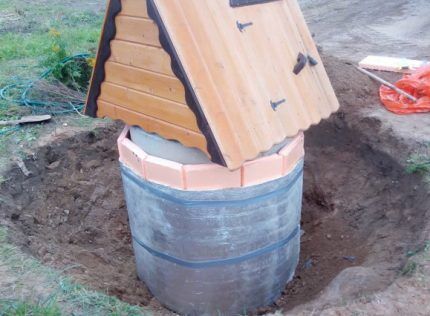
Option #2. water well
The best option is equip a well. You can’t do this without special equipment—you can’t drill a well with a shovel. The main advantage of such a water supply source is the purity of the water.
The depth of a well for a private house starts from 15 m. At this depth, the water is not polluted by nitrate fertilizers, household waste and other agricultural waste.
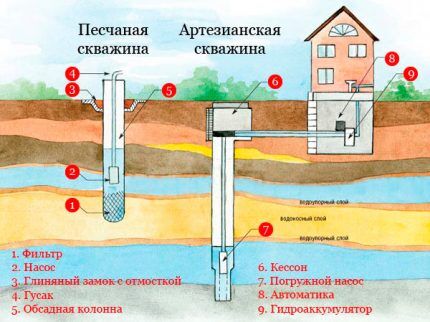
Drilling a well will cost much more than digging a well, and it is not easy to maintain: constant cleaning, preventative maintenance, and flushing. But 1.5 cubic meters per hour, which can be lifted from a well, provides almost unlimited consumption of clean and fresh water.
Option #3. Connecting to the central water supply
If there is a centralized water supply near your site, you can connect to it. Among the advantages of this option are constant pressure and water purification.However, in practice, the pressure often does not meet the standards, and there is nothing to say about cleaning.
In addition, you will not be able to simply connect to the pipeline - it is illegal. You will have to write an application to the water utility, provide a site plan with all communications, draw up project documentation and obtain permission from the sanitary and epidemiological station. The whole procedure takes several months and costs a pretty penny.
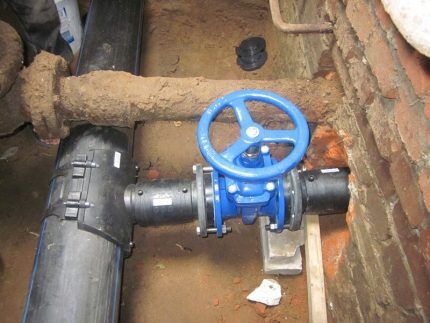
It is also impossible to use such water uncontrollably; for each cubic meter used you will have to pay at the established tariff. Based on all of the above, not only many summer residents, but also residents of private households make their choice in favor of drilling a well on their site.
Winter or summer water supply?
Depending on the cyclical use, there are two options for the plumbing scheme:
- all-season (winter);
- simplified (summer).
If your site is used exclusively during the summer season, that is, from spring to autumn, spending money on expensive capital plumbing simply does not make sense. In this case, there may be two options - a collapsible water supply and a stationary one.
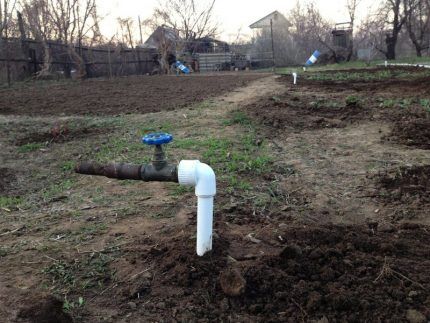
The first one is very convenient because at the end of the season all hoses can be removed and stored. This way they will not deteriorate from the cold and will last longer. To lay such a water pipeline, you don’t even have to use a shovel - all communications pass on the surface.
It will take a little effort to laying summer water pipes stationary type. It also does not require the presence and installation of complex equipment, but differs in that the pipes are underground and are not removed for the winter. Collapsible taps are installed in the right places.
The main condition is to completely drain the water from the system for the winter, so that at sub-zero temperatures the frozen water does not burst the pipes.
A summer water supply will be quite sufficient for basic household and agricultural needs on the scale of one summer cottage. But if you are used to comfort, use your dacha as a place to relax and want to use water in the same way as at home, within the city, then it is better to do it at your dacha winter version of water supply.
Winter plumbing is a much more complex system. Everything must be taken into account - from the natural slope of the terrain to the depth of soil freezing. A pump is required to provide water pressure. In short, a winter-type country water supply system is no different from the water supply system for residential private houses.
Construction of a typical plumbing system
The water supply system in a summer cottage consists of several elements:
- pump equipment;
- pipes and fittings;
- pressure switch and pressure gauge;
- hydraulic accumulator;
- draining device.
In addition to the above, the system may include other elements, such as a storage tank, filters or heaters. Some components can be combined in one complex, for example, a pumping station.
Raise water from a well - choosing a pump
Water is supplied from a well or borehole using a pump. Choosing a pump is one of the most important tasks when planning the water supply of a summer cottage.
The choice of pump depends on:
- depth of the well or borehole;
- volume of consumption;
- productivity of the well itself (discharge);
- well diameter;
- water pressure;
- financial component.
Some of these parameters cannot be calculated exactly; rough estimates are made. To do this, it is better to consult with an experienced master so as not to make mistakes.
There are two types of pumps:
- submersible;
- surface.
The surface version is used only for pumping water from a well. It can be placed on the surface or inside the well, but float. The maximum depth for which a surface pump is suitable is 8 m.
If your well is deeper or we are talking about a borehole, then this type of pump is not considered.
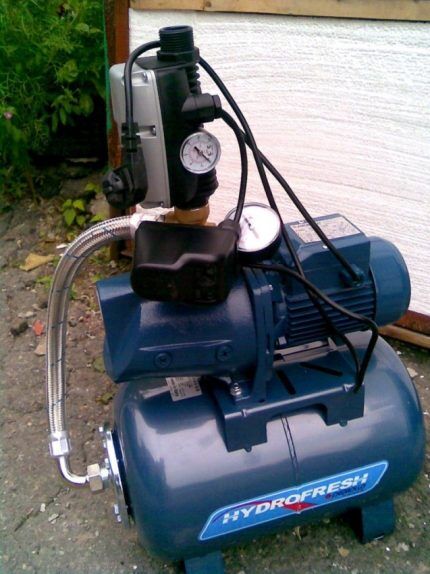
For wells choose submersible pumpswho are not afraid of water. Their advantages include low energy consumption and silent operation with a high level of performance.
There are 2 types of submersible pumps, depending on the type of action:
- centrifugal;
- vibration.
Centrifugal pumps pumps liquid using blades.Under the influence of centrifugal force, which arises as a result of the rotation of the blades, water enters the pipeline and moves through it.
These models are the most popular because centrifugal pumps combine: reliability, high performance and affordability.
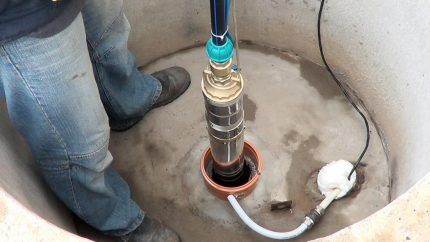
Vibrating pumps have a finely porous membrane in their structure. The liquid is pumped as a result of a pressure difference caused by membrane deformation.
Such a pump requires more careful maintenance; the membrane can become dirty and fail. It is possible to fix such a breakdown, but repair or replacement will be expensive.
What pipes are suitable for country water supply
Water is supplied to the house and for household needs through a pipeline. The most commonly used pipes are 1 or ¾ inch in diameter.
Modern materials suitable for country water supply include:
- polypropylene;
- polyethylene pipes.
Each of the varieties has its pros and cons. So, polypropylene pipes more expensive than polyethylene. To connect them, you need to get a special tool - a soldering iron or a pipe welding machine.
But on the other hand, you don’t have to buy a soldering iron, but rent it for the duration of installation, but the savings on connecting fittings are significant, especially if the pipeline diagram involves a lot of branches.

Polyethylene pipes are cheaper, but to connect them you need to buy metal elements, which in total cost more than the entire pipeline. And it is impossible to guarantee a completely sealed connection, as when working with a soldering iron and a polypropylene pipe. Joints are the weak point of polyethylene water pipes.
To prevent the winter water supply from being damaged by low temperatures and freezing, you need to take care of insulating the pipeline. A modern solution is special tubular “covers” made of foamed polypropylene. This simple solution can protect your pipes from freezing and cracking.
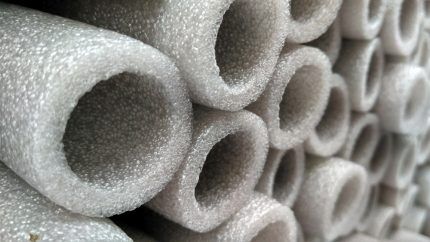
Another insulation option is a heating cable. It is laid parallel to the pipeline along its entire length. During the cold season, the cable warms the pipes and prevents freezing. But, of course, there are electricity costs to ensure constant heating.
Dismountable and shut-off valves
Water fittings are also of great importance. The reliability of the entire system depends on its quality. You can install ordinary faucets in a country kitchen, bathroom or bathhouse, but they are not suitable for outdoor installation.
Outside, it is better to install much more reliable and practical taps with grand axles or bronze valves.
The input dispensing unit is located on the surface, for example, in a utility room or a specially designated place in the house. It includes a set of valves that cut off certain branches of the system, a device for measuring, monitoring and regulating pressure.
System pressure monitoring
For comfortable use, the pressure in the system must be constant. The normal value is from 2.5 to 4 atmospheres. Both too low and too high indicators are not allowed. To control this parameter, the system is equipped with a special complex - pressure switch and a hydraulic accumulator.
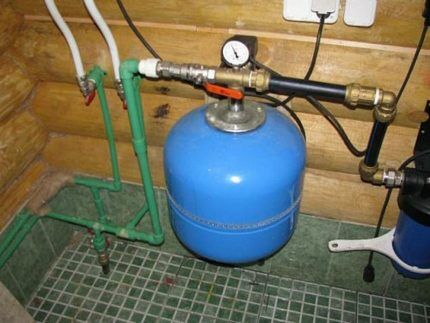
The hydraulic accumulator is a tank that is filled with water from the system. A relay is installed behind the hydraulic tank. This device measures the water pressure in the system.
When it reaches the maximum permissible level, the pump turns off, and water continues to be supplied from the battery tank. When the pressure stabilizes, the relay starts the pump again and fills the tank.
Another important device for proper installation of water supply in a country house is a lack of water sensor - a dry relay. It will turn off the system when there is too little water in the well for some reason and will prevent overheating and damage to the pump.
Water storage tank
The pressure in the country water supply system is ensured using a water tank. Its role is usually played by a large-volume plastic barrel located on an elevated surface. If there is space in the attic, it is placed there.
If you have an attic floor instead of an attic, the water barrel can be placed on a specially built tower or trestle.
If the tank is located in an unheated room, and periodic residence at the dacha in winter is planned, then special care should be taken to insulate it. This can be a protective structure insulated with foam or mineral wool.
The main thing is to carefully ensure that the tank is sealed.Otherwise, particles of insulation, as well as dust and debris, can get inside and contaminate drinking water.
Drain valve for system preservation
There are situations when the water supply system has to be preserved, for example, during a long departure or repair. In such cases, all water should be drained from the system. To do this, immediately after the pump, that is, at the lowest point of the system, install a drain valve.
If you turn off the pump and open the valve, the water will begin to flow in the opposite direction through the pipeline due to the slope. Sometimes they do it differently and install a check valve and a bypass pipeline - a bypass. This scheme is used when using water from deep wells and boreholes.
How to organize a sewer system for water disposal?
Since there is practically no central sewage system in dachas, you need to take care of an individual solution for draining wastewater and liquid household waste.You can dig a cesspool the old fashioned way, but this does not meet sanitary standards. Yes, and such a pit will have to be cleaned often.
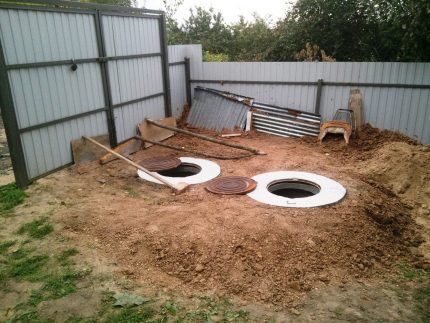
Modern solution – use of a septic tank. The simplest and most common method is a septic tank made of 2-3 concrete rings. Although there are more advanced technologies, such as the Eurocube, for example.
The task of the septic tank is to separate the solid component of the wastewater, and drain the relatively clean liquid component back into the ground. Thanks to such a system, you can get by with one call to a sewer truck every few years.
Step-by-step installation guide
In order to build a water supply system at your dacha yourself, you need to do preparatory work: draw up a plan, prepare tools and materials. Only after careful preparation can you begin laying the pipeline, connecting and installing internal wiring.
Step 1. Drawing up an action plan
You need to start work by drawing up a detailed plan. If the planned scheme is complex, you cannot do without the help of a professional, because plumbing is a responsible matter.
If you decide to do it yourself, prepare all the information:
- depth of soil freezing in your region;
- depth of groundwater;
- relief slope;
- plan of existing communications indicating water intake points;
- site plan with all buildings;
- number of consumption points (water supply to the house, bathhouses, watering the garden, filling the pool, etc.).
First draw a detailed diagram to scale. In addition to the usual site plan, draw a profile image of the pipeline and an isometric plan.This way you can take into account the slope when laying water pipes in your country house.
If you have such a drawing, calculating the number of pipes and fittings will not be difficult. Never buy material back to back, make a small supply - about 10% of the total quantity.
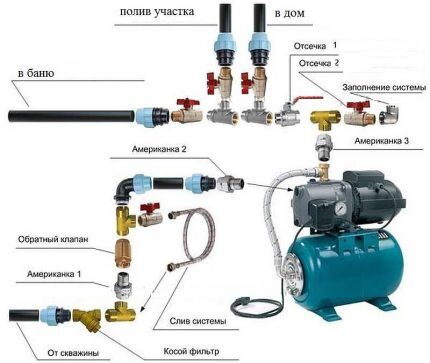
Freezing depth is one of the most important characteristics. It depends on how deep the pipes will have to be laid. Please note that the depth of pipe installation must be at least 20 cm greater than the freezing depth of the soil at the lowest point of the site.
Step #2. Preparing the necessary tools
When the diagram is ready, the materials have been calculated, you need to take care of the necessary tools. Let's assume that you already have a well or a well, so you can skip the construction step.
Tools for installing winter water supply in the country:
- shovel;
- adjustable wrench;
- gas key;
- welding machine for pipes - “iron” (when using polypropylene);
- roulette;
- pipe cutter;
- hacksaw;
- knife;
- gun for silicone and sealant.
This set will be sufficient for excavation and plumbing work.
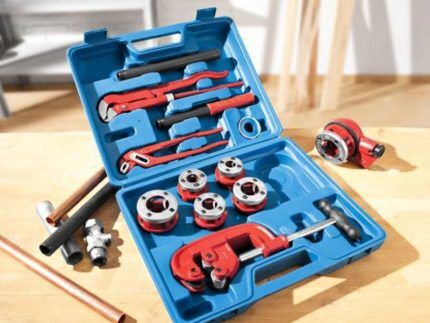
If you plan to carry out electrical installation work yourself, then you need to expand your tool kit with a screwdriver, tester, wire cutters and other electrician tools.
Step #3. Water supply installation
To organize your work correctly, you need to know the correct order:
- Carry out excavation work. Armed with a shovel, begin constructing trenches along the entire length of the water pipeline according to the drawn up plan.
- Take care of the power supply to the pump. You need to dig a separate trench, lay an electrical cable and install an outlet to connect the pump.
- Install the pump. Depending on its type, it can be located outside or immersed in the well;
- Connect equipment to the pump: pressure switch, pressure gauge and hydraulic accumulator. Then securely connect the pipe leading to the consumption points.
- Install the drain valve for possible preservation of the system.
- Install the piping system along the bottom of the trench. Don't forget about insulating the pipes at this stage.
- Remove external water points.
- Connect the system and check its functionality. Particular attention is paid to pipe joints, as well as equipment connection points.
- Fill the trench. They proceed to this stage if the system is operating stably and there are no leaks.
- Install internal plumbing. Plastic pipes do not rust, so they can be recessed inside the walls. Install all faucets, plumbing fixtures, filtration systems and water heaters.
Well water must be purified. This is best done using flow filters or reverse osmosis systems. The latter provide complete purification from all impurities at the molecular level, but the cost of their installation and maintenance is much higher.
Step #4. Selecting a water heating device
To heat water in the country, you can use flow-type water heaters (gas or electric) and storage type (boiler).
Gas water heaters are very convenient; water is heated in unlimited quantities, quickly and efficiently. And you can save on electricity.But, firstly, a gas pipeline in a dacha is a rare phenomenon, and there is no point in connecting a water heater to a gas cylinder, and secondly, the installation of the water heater should only be carried out by a qualified gas technician.

Electric heaters can be installed and dismantled at any time, this is their advantage. However, in terms of heating speed they are inferior to gas flow columns.
An electric boiler is the best option for use in the country. Hot water is always available, it is inexpensive and any beginner can install it.
Conclusions and useful video on the topic
In order to understand how to lay a water supply system in a country house, watch these visual video tutorials. From them you will learn how to install a water supply system from a well, a water well, and also how to make a summer water supply option at your dacha.
Video review of laying a water pipeline with a surface pump from a well:
Instructions for installing a summer-type country water supply system:
And these are instructions for connecting all equipment - pressure switch, dry-running relay, etc.:
If you follow all our recommendations, you will be able to install a water supply system in your dacha without the involvement of professionals.
Are you trying to install your own country water supply or have successful experience in implementing water supply? Or maybe you don’t agree with the material presented? We look forward to your comments and questions. The contact form is located below.




Everything is described, of course, very cool. This summer we installed water at the dacha.We dug a well with 7 rings. Plus we bought a pumping station. My personal opinion: this is an ideal option for a summer cottage. We arrived, pumped out all the water from the well and began to “pump” clean water. The pumping station can be taken home for the winter. This is the simplest and most inexpensive option. I also want to buy shungite stones, they seem to purify water too.
Sewage is the simplest: a pipe from the house to the garden. But, again, we have a summer option. For the winter, I would lay pipes underground.
Hello. Unfortunately, the cleansing properties of shungite, as well as its price, are greatly exaggerated. Basically, it saturates the water with globular carbon, the purifier from it is insignificant. It is not for nothing that store-bought filters with shungite always contain filter elements other than these stones, for example, activated carbon.
We installed water supply to our private house in the village. There is no central water supply or sewerage nearby, but I really wanted amenities. They got out of the situation themselves. We pump water from the river (it is about 100 m from the house) using a pumping unit. We have a buried barrel as a sewer system, where the drainage from the toilet goes. We pass household water through two carbon filters and pump it back into the river. The system has been working flawlessly for a year now, there is no smell in the toilet, and the pipes are not leaking. A month ago, they called the vacuum cleaners to pump out the wastewater from the barrel. We wash ourselves in the bathhouse, the old fashioned way. There is only running water in the house.
There is no point in insulating water pipes with thermal insulation. If you only lower the pipe below the freezing level of the soil, but then why thermal insulation? Carry out an experiment - expose a piece of pipe in this insulation with water inside to the cold.It will not freeze only if there is electric heating.
It makes sense to insulate, because... insulation gives + to your burial depth, i.e. if you lay a pipe at a depth of 1 m, this is the freezing depth, and if the pipe is insulated, then consider that the pipe is at a depth of 1.5-1.6 m. Something like this 🙂 On the surface - what’s in the insulation and what’s without it. But if you dug it in, then it’s approximately +30-60cm to the depth of the pipe.
Sani Sticks are an excellent helper in getting rid of blockages and negative odors in the drain area and discharge into the drainage system.
They contain enzyme complexes that improve and accelerate the processing of all types of organic deposits on the inner walls of pipes.
One package is designed for a year of use.
I want to share my experience in country water supply. Water is supplied from the well by a submersible pump through a ¾-inch PVC garden hose. The hose without insulation and without a heating cable lies on the surface of the earth, partially underground at a shallow depth. I have been using this system for more than 10 years. And the water in the hose never froze.
Because:
1). I poked a hole in the hose next to the pump with a 2 mm awl. When the pump is turned off, the water from the hose slowly flows through the hole back into the well and does not freeze even in severe frost.
(Water also flows out through the hole when the pump is running, but this has virtually no effect on the overall performance).
Now, instead of a vibration pump, I have a centrifugal borehole pump. I screwed the outlet fitting to it without a sealing gasket. The result is the same.
2). The hose along its entire length has a greater or lesser slope towards the well.Water should not linger in it.
3.) Another mandatory condition: the water inlet into the storage tank must be higher than the water level in it, otherwise, when the pump is not working, water will flow back into the well not only from the hose, but also from the storage tank.